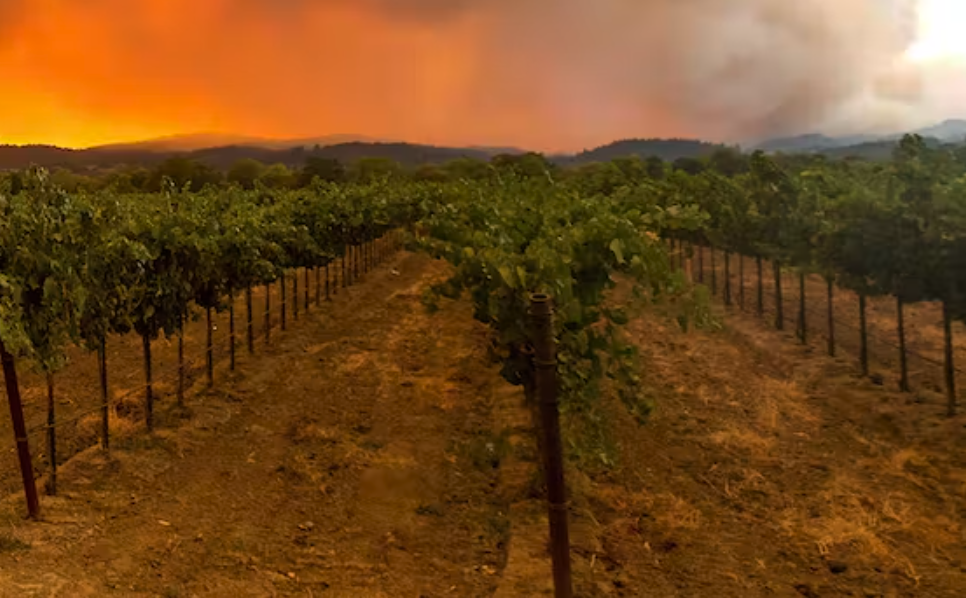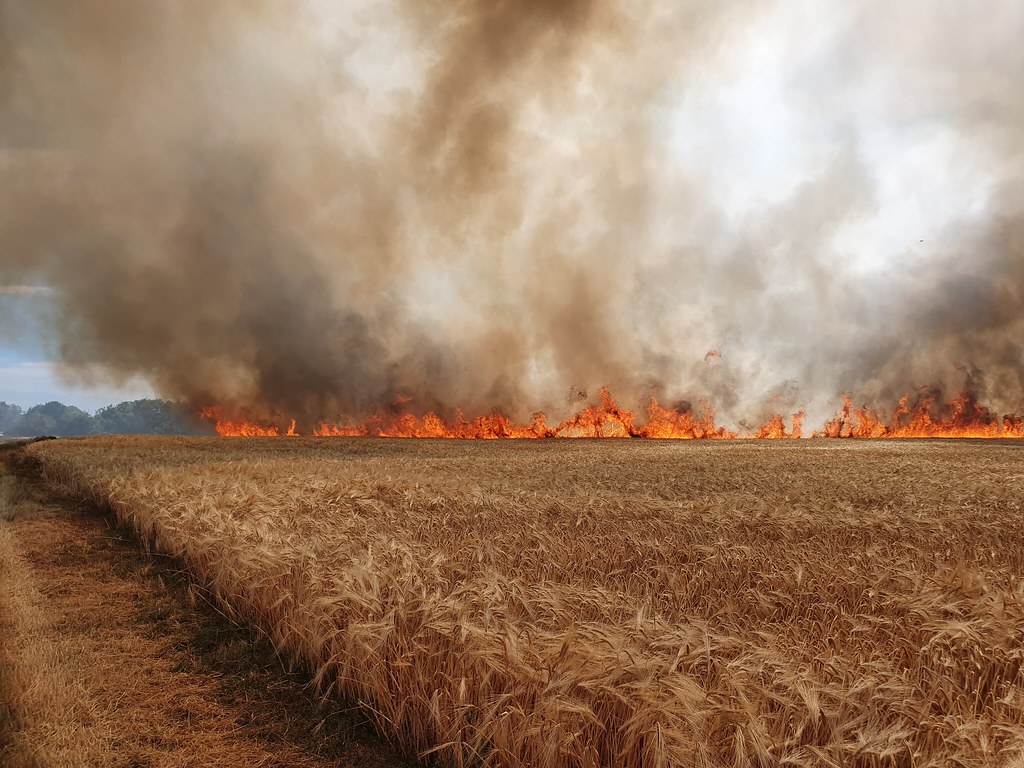Impact of wildfires on agriculture
Landscape fires are an integral part of our world, serving an important purpose for the ongoing survival of ecological communities. However, they can also be disastrous when they burn out of control and become wildfires that impact negatively economic, social, and environmental assets and values. The magnitude of wildfires is increasing not only due to climate change, but also due to changes in land use, land management practices, and demographics. Around the world, from Australia to Canada, across Europe, China and the United States, escalating wildfires destroy the environment and its wildlife, wreak havoc with human and animal health, and bring additional risks to the availability of food.
Never before have the threats to our food supply been so diverse and interconnected. From old enemies, such as floods and droughts, to new ones like climate change and pandemics, agriculture is under siege from all fronts. With disasters becoming more frequent and intense than ever before, we must act now if we want to protect ourselves from a catastrophic risk that could destabilize our entire global food system. But despite the heartbreaking stories of those taking care of the land and forests who have lost everything, there are solutions to this global problem. One of them is exci’s AI-powered early wildfire/bushfire detection technology that can significantly reduce the impact of wildfires on agricultural land by alerting farmers, plantation/forestry owners, or other agricultural landowners of a fire within minutes after ignition. In this blog post, we will take a look at how extreme fire events negatively impact our agricultural sectors and threaten our food security, and then how artificial intelligence can help farmers and owners of plantations, forestry, vineyards, or orchards to protect their land from the severity of wildfires.
Agricultural production losses from wildfires
Wildfires have an enormous impact on food production. The immediate consequences of climate change are numerous, such as smoke inhalation, alterations in agroecological conditions, and destruction of crops, livestock or harvested products. Indirectly, the repercussions on food production are increased transport costs leading to reduced accessibility for food items; loss of income as a consequence of decreased activity in hospitality and tourism industries; and an increase in greenhouse gas emissions exacerbating climate change even further. Agriculture production is one of the most impacted economic sectors by climate change and its consequences, such as increased and more intense wildfires.
Wildfires lead to soil erosion because the water runs faster on the bare, unstable ground in severely burnt forests, resulting in decreased soil fertility. The changed soil composition and the toxic combustion products negatively impacting the water catchments affect both yield and quality for extensive periods. The smoke from the fire can wreak havoc on vegetation, resulting in minimal harvest yields and poor produce quality – adversely impacting profits. Smoke inhalation by livestock has also been linked to reproductive losses, consequently leading to food insecurity since fewer resources are available for consumption. Additionally, nutrient loss induced by smoke exposure renders fields infertile, further exacerbating food production deficiencies. Additionally, smoke can damage certain fruits and vegetables. For example, smoke alters the chemical composition of grape berries, leading to a smoky aroma that results in significant economic losses for grape growers and winemakers.
 Source: Up in smoke: How wildfires are tainting grapes and threatening the wine industry
Source: Up in smoke: How wildfires are tainting grapes and threatening the wine industry
The changing scale and intensity of wildfires also impact the United Nations’ Sustainable Development Goals to achieve food security, improve nutrition, ensure healthy lives and promote well-being because wildfires affect negatively the air, water quality and soil fertility, creating a compounding effect with grave consequences for food security globally.
The impact of ravaging wildfires scorching through millions of acres across California (2017, 2020), Greece (2018), and Australia (2019/2020), to name a few, has been enormous. In 2017, 500 acres of Californian vineyards have been damaged and 2,000 acres of wine grapes could not be harvested, causing an estimated $75 million in economic damage. In 2020 wildfires burned more than 4.2 million acres, exceeding the potential agricultural losses of the 2017 and 2018 fires in California. Australia, one of the hottest countries, has not been spared by wildfires. In 2019/2020, the Australian bushfires claimed 18.6 million hectares of land. In southern and eastern Australia, an astounding 10.3 million hectares were affected – 8.5 million ha being forest (mainly native species on public land) as per ABARES (2021a). Approximately one-fourth of all areas hit by fires were agricultural lands, causing approximately nearly 5 billion in economic losses to the Australian food supply.
The 2018 wildfires in Attica, Greece were the result of a global trend of rising temperatures leading to prolonged drier summers, an extremely hot day when the wildfires erupted and coupled with wind gusts upwards of 56 km per hour. Because there was no alarm system in place, the uncontrolled flames gained speed growing to 6 kilometres in length when they reached the settlement, hindering the residents to flee. Over 100 people lost their lives. 1,431 hectares of agro-forestry vegetation was destroyed.
The impact of climate change on wildfires
Climate change is having an undeniable impact on the frequency, intensity and severity of wildfires. Increased temperatures and droughts make it easier for fires to spread quickly. In addition, drier soil conditions are limiting the ability of vegetation to recover, thus leading to more fuel for fires. Extreme weather events associated with climate change such as hurricanes can result in wind-driven firestorms that devastate entire regions. The Food and Agriculture Organisation of the United Nations (FAO) analysis (2015) showed that 25% of economic losses and damages affect the agricultural sector. Yet, according to FAO, food production will have to increase by 60 per cent by 2050 to satisfy the growing demand of population growth. The decreased productivity of livestock, crop yields, and trees caused by factors such as droughts, temperature stress, or water erosion is aggravated by the increased frequency of wildfires, bringing additional risks to food security and translating into economic and social consequences, for both farm and non-farm households.
In addition, the escalating fire risk during catastrophic fire conditions makes the situation extremely dangerous and more demanding than ever for firefighters, introducing new challenges and growing environmental risks. Facing increasingly intense and frequent droughts and wildfires, the farmers and businesses who depend on agriculture face huge challenges. For these reasons, wildfire prevention strategies need to be taken seriously to mitigate the effects of climate change and protect people, property and natural resources from further harm.
How farmers are preparing for more frequent and intense wildfires
As wildfires become more frequent and intense, farmers are taking steps to ensure their herds, crops and livelihoods are protected. Many are changing the way they manage their land by reducing the amount of brush and other highly combustible materials that can fuel flames, while others are taking a more defensive approach and implementing fire-resistant materials in infrastructure and building fire breaks near property borders. In addition to protecting existing resources, many farmers are focusing on restoring degraded landscapes and ecosystems that also help protect the surrounding communities from the threat of wildfires.
After decades of scepticism, farmers practice targeted grazing of sheep, goats and cattle to reduce fuel loads of grasses and shrubs. Practising Agroforestry in which native grasses, shrubs, and trees are integrated into crops or pastureland have the benefit of greatly enhanced yields from staple food crops but also reduced erosion and fuel load management. Firebreaks such as vineyards, fields or grazed landscapes may be strategically employed to reduce the speed of wildfires. By actively planting native vegetation, increasing soil water levels, removing invasive species, and replanting after fires have passed, farmers can reduce their wildland fire risk.
However, the unprecedented fire conditions worldwide aggravated by climate change pose a serious threat to the agricultural industry. Under extreme weather conditions, the methods just listed might still not be enough to prevent severe wildfires. The arrangement of dry fuel, the landscape’s topography, and wind speed all affect the severity of wildfires. In addition, some agricultural land is at higher risk than others. When fires expand to become mega-fires, they can be incredibly difficult to control due to the hundreds or thousands of kilometres that make up their perimeter. And when multiple mega-fires burn at once, it creates a whole new set of issues in terms of resources and manpower needed for containment. Fire departments are tasked with the difficult decision of weighing risk against reward and allocating increasingly scarce resources. This means that as more fires erupt, there are fewer personnel to address them and a greater chance for these blazes to inflate in intensity. Despite the unprecedented deployment of large and very large air tankers (LAT & VLAT), no new firefighting strategies or techniques have been identified to contain mega-fires, such as those seen in Australia during 2019-20. Even with an influx of LATs & VLATs, these major blazes were not brought under control.
Given the intensifying and more frequent bushfires, it is of paramount importance to adopt innovative solutions that enable early bush/wildfire detection, empowering ground-based and aerial firefighting sources to rapidly respond, attack, and contain bushfires as quickly as possible before they get out of control and overwhelm firefighting capabilities.
How utilising AI can help early bushfire detection
A key determinant of whether a fire turns into a large and devastating fire is the time between ignition, detection, and first attack response. Every minute counts! Monitoring many cameras requires dedicated staff who constantly and diligently look at live image streams to detect fires manually. Apart from being costly, maintaining attention when performing monotonous tasks such as looking at very slow-changing images for many hours is very difficult. The answer to this problem is to leverage the power of innovative AI-powered early wildfire/bushfire detection technologies. AI stays focused 24/7 and processes and analyses data faster and more accurately than any human ever could. Since the first sign of fire is smoke, AI systems need to be taught how to differentiate between smoke, fog, cloud, dust etc. However, training deep learning algorithms requires massive amounts of data to identify patterns, learn from examples and make predictions.
exci’s AI-powered early wildfire detection system has been trained on large datasets of over one billion images per year from ground-based cameras and more than 500,000 satellite images for the presence of smoke and heat to achieve high accuracy and speed. exci’s system detects even small fires (as small as a garden shed) automatically within minutes of ignition, with a near-zero rate of false positives. In addition, exci receives and processes more than 2.5 million images per day. This large amount of data enables us to continuously build, train, and deploy its advanced machine learning models, improving fire detection time [time since ignition] with high levels of geospatial accuracy.
exci is the only early bushfire detection system that has been proven in large-scale deployments with nearly 1,000 cameras in California (over 125 million acres) and commercial deployments in Australia (over 2 million ha of forestry and plantations).
Since the inception of our system, we have successfully detected an astonishing 110,000 fires and counting., significantly reducing the economic, environmental, and social impact on exci’s customers and their communities. Check out the following short video of how it works!
Don’t let hazardous events become catastrophic!
Get in touch with our friendly team who are happy to give you a full demonstration of how exci’s system detects wildfires within minutes and can help you to protect your assets and community:
Australia:
Phone: 1300 903 940
International:
Phone: +61 458 594 554
email: info@exci.ai:
Visit us on our website and find out more https://www.exci.ai/
by Gabrielle Tylor
exci

